Your business won't succeed by doing the same thing as everyone else.
Content marketing is powerful, but it’s also hugely competitive. If you’re just rehashing the same points as everyone else, you won't get anywhere.
Your business is unique and so is your audience. If you want to make the most of content marketing, you need to produce content that is helpful, detailed, and different.
Below, we'll cover 30 content marketing strategies that will help your brand stand out, but first, let's cover why content marketing matters in 2021.
Why Is Content Marketing Important in 2021?
What brings people to your business in 2021?
In many cases, it starts with a question and they come to your website for a solution. They expect your business to solve their issue, but it’s not just your product they're looking for.
They want information.
In many cases, content is the moment when your relationship with the customer begins, and that content is going to be with them through every step of the customer journey.
Your content marketing tactics are as important in 2021 as ever because the modern consumer craves an experience. It’s not just about your products or service, it’s about how people interact with your business—and your content plays a huge part in this.
Content marketing ticks nearly every box for your business. It helps:
- bring people to your website
- engage customers by offering value
- generate leads
- move people through the customer journey
- drive sales
- provide post-sale care

Content marketing isn't just good for customers; it drives profits. In fact, the yearly ROI for a successful content marketing campaign is $984,000.
This is why 70 percent of marketers are actively investing in content marketing. Really, the number should be higher with all the benefits content marketing has to offer.
How to Choose Which Content Marketing Strategies Are Right for Your Brand
Every business is unique, and each one will use different content marketing tactics. What works for one website might not necessarily work for another, so what’s important is that you find the blend that works for you.
When it comes to content marketing, you'll want to be particularly aware of your brand voice. For example, if you’re a highly respected law firm that people look to for advice, strategy number 22, “Be a little weird,” might not be the best option.
This is where it pays to sit down and brainstorm before you create your content marketing strategy. Understand what your brand stands for, how you want to convey your values, and the goals you want to achieve.
Once you’ve worked out these details, it’s much easier to pick and choose which content marketing tactics will work for your brand.
30 Content Marketing Tactics That'll Skyrocket Your Search Traffic
I’ve experienced the power of content marketing first hand. It’s what my entire business is based on, and I want you to achieve the same kind of success through your content. Over the years, I’ve tried out lots of different content marketing tactics, some of which have paid off big time, others that have crashed and burned.
By trying new things and not being afraid to get creative with content, I’ve narrowed my list down to 30 content marketing tactics that’ll skyrocket your search traffic.
1. Build More Targeted Landing Pages
My search traffic almost tripled when I created advanced guides for SEO and several other internet marketing topics. Each of those advanced guides has a separate landing page, optimized for the applicable keywords.
Mailshake, a comprehensive email outreach platform, had success with this, repackaging its cold email masterclass into an eight-part email series. This allowed them to create targeted landing pages and offer user-specific content that matched their place in the customer journey.
In under a year, Mailshake acquired 5,321 email opt-ins for its masterclass.
Or, take a look at Copyblogger Media. Copyblogger has dozens of landing pages, each aimed at a keyword that the target audience is passionate about. That’s a lesson for you when developing a sound content marketing strategy: when creating more landing pages, think strategically about keywords and build your content around the right ones.
The easiest way to start creating high-quality landing pages is to use templates.
There are plenty to choose from, but I like Unbounce and Instapage. Both are paid platforms, but they're a great way to create effective landing pages quickly.
2. Segment Audience to Increase Engagement
Smart content marketers know they need to segment their audiences based on product need. Segmentation is crucial for one simple reason: some of your blog readers aren’t buyers, but others are.
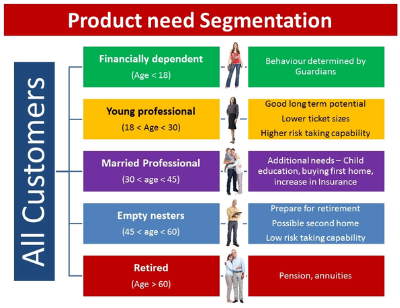
Simply put, your content can’t suit everyone because people are at different phases of the buying cycle. So, for example, content designed to create awareness with new customers is wasted on loyal repeat customers.
Make the most of your marketing efforts by segmenting customers based on their personas. Remember, a buyer persona is a fully fleshed-out profile of one segment of your audience. It enables you to develop content that speaks to each segment more effectively.
Here's an example of one in action:

Segmenting your target audience is difficult on your blog or website (though not impossible with content personalization), but email segmentation is pretty simple.
Email list segmentation is a must if you want to get the most from your list. According to Campaign Monitor, marketers who used segmented campaigns saw a 760 percent increase in revenue. Not too bad!
Check out my article “How to Use Email Segmentation to Increase Conversion Rate” to find out how email segmentation can boost your content marketing.
3. Know Your Audience, and Give Them What They Want
Before you can create successful, engaging, and overall great content, you’ve got to know your audience very well. The first step is to perform keyword research to discover what your ideal customers are looking for.
Start by getting a better idea of the existing demand for your topic through Google Trends. Just type your main keyword into the search box to learn how many searches it received within a specified period.
For instance, here’s the Trends graph showing the popularity of the keyword “content marketing:”
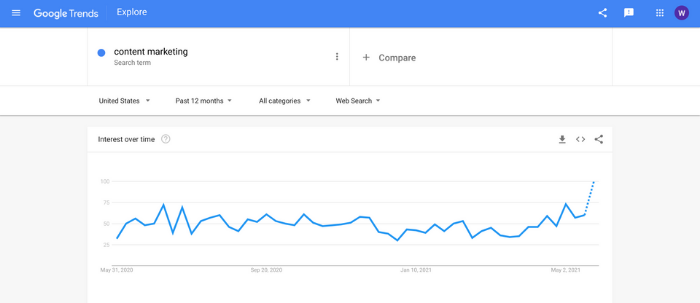
This will give you a rough overview of how people are searching for your keywords, but for more detailed information, you should look at Ubersuggest.
Follow these simple steps to gain access to hundreds of keyword opportunities you can use to build engaging content.
- open Ubersuggest in your browser
- enter your domain
- Select keyword analyzer from the left sidebar
- choose keyword ideas
- enter a keyword and see related keywords with search volumes

Remember, the more you know about your readers, the more precisely you can base your content creation on them, and the more effective your whole content marketing strategy will be.
If you want to dig in deeper, here's a complete guide to keyword research, including tools, tips, and examples.
4. Focus on Facts and Data
Sometimes, you need to personally verify results or data through experimentation. What was true five years ago, or even last year, may no longer apply.
Instead of accepting everything you read on other sites and blogs at face value, get in the habit of thinking tactically and critically.
Results are relative. You may experiment and get a different result. Through observation, brainstorming, and A/B testing, you can come up with a new concept that others can learn from.
That is how you become a content marketing expert; not just following the rest of the crowd.
5. Target Millennials and Gen Z With Adaptive Content
Millennials and Gen Z now make up a huge segment of the U.S. population.
There's a good chance these groups make up a large chunk of your target audience, so your content should speak to their needs and values.
Both of these groups grew up with technology as a big part of their lives, and so they have high expectations for how businesses use technology. They also value experience above almost anything else, and this plays right into content marketing.
While both groups have similarities, you need to target each of them in a slightly different way. Find out more about how to market to Millennials, and target Gen Z.
Adaptive content is one way to go. Adaptive content is simply the content that supports meaningful interactions across different platforms. Think of it like water—whatever you pour it into; it takes the shape of that container.
For example, you might use their name at the top of a booking site or suggest content based on their past interactions with your brand.
Your readers should be able to access your content on a desktop computer, then continue where they left off using their smartphone or complete their purchases through your mobile app, with absolutely no hassles at all.
6. Leverage the Hedgehog Content Model
A hedgehog is a small mammal with stiff spines and a small, pointed snout. What does a small mammal have to do with content creation and your marketing strategy? (There's a point, I promise!)
The hedgehog concept is based on an old parable about a hedgehog and a fox. The fox knows lots of things—he's constantly trying new ways to best the hedgehog. The hedgehog, however, stays focused on one big idea.
What does this mean for your content strategy?
It simply means you should start where you are and stay focused. Why worry about the fact your blog isn’t generating 1,000 monthly visits yet? Instead, create content consistently and use a content marketing strategy to reach your goals.
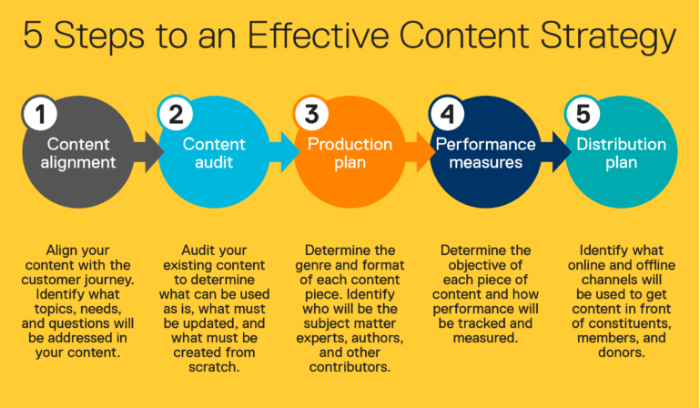
Instead of obsessing over reaching 1,000 monthly visitors, for example, focus on 100 each month. Just make sure that your goal is realistic and measurable.
If you’re able to hit that smaller goal, the hedgehog model says to treat them well and deliver great content they’ll share with their friends across their social media channels.
Apply the same technique to your email list. Focus on getting three to five subscribers every single day, instead of your first 100 subscribers. By the end of the month, you’ll have 90 to 150 email subscribers.
7. Consistently Run A/B Tests
Are you consistent at split testing? A study by AdPushUp showed conversion rates typically range from one to three percent. A/B split testing helps you drive that rate up, and even a single additional percentage point in your conversion rate can be significant.
Whether you’re on a team of B2B marketers or you’re a small business owner, running A/B split tests is crucial to know for certain which headlines, calls-to-action, and types of content work best for your readers. Once you know what strategies work, your work becomes much more effective and your overall content marketing strategy much clearer.
You can split-test just about anything. Since you’re concerned about search traffic, however, you should focus on the elements that impact search performance, such as headlines, site speed, visuals, landing pages, CTA, and so on.
As Rohan Ayyar says,
Instead of a one-size-fits-all philosophy, create multiple landing pages for the same call to action to suit the user’s preferences.
A/B split testing can send more targeted buyers to your product pages, as well. For example, Lyyti.com, an online event management software company, ran a split test on their product pages. They set up a product page variation and tested it against the control.
At the end of the testing, the variation page performed better. It clearly showed the features offered in each plan, while the original design wasn’t quite clear enough. Implementing the results of this test increased visits to their “Free Trial” sign-up page by 93.71 percent.
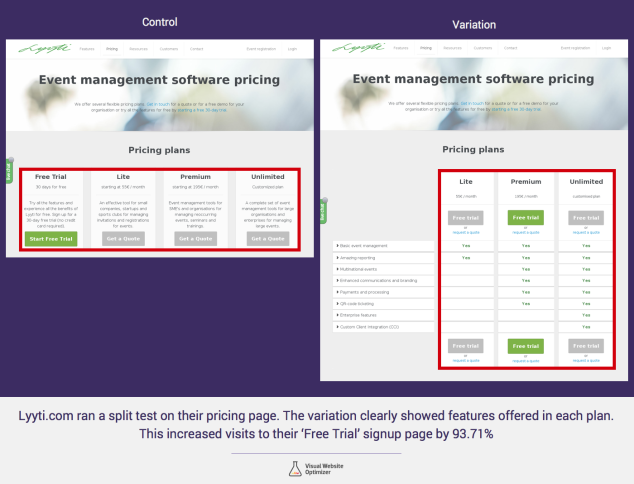
Mobile testing is also crucial. The majority of search traffic comes from mobile devices now, so you have to offer a good mobile experience.
You can’t afford to run A/B split tests solely on desktop users. If you’re experimenting with mobile testing, look at any key user behavior, especially behaviors related to conversions, such as email opt-in form and landing page preferences.
8. Learn From Topic Training Modules
Content marketing is a lot easier these days, considering all the statistics, data, and content that can be accessed for free.
According to KPMG, 90 percent of corporations use online learning compared to just four percent in 1995. People visit these online training sites in part because they’re effective. E-learning is proven to increase knowledge retention by 25 to 60 percent.
This is good news for content marketers because with online learning platforms like Udemy and LinkedIn Learning, you can benefit from all that useful content provided in their courses and modules.
Essentially, you can pick the brains of experts in different industries to create top-notch content for your target audience. There’s no longer any need to waste tons of time researching your topic because someone with better training, resources, and time has done all that for you.
So, let’s say you want to create an in-depth article about link building. Here’s how to research your topic using Udemy:
- Step #1: Go to Udemy.com. Type your main keyword (e.g., link building SEO) into the search box. Hit the enter button on your keyboard.
- Step #2: Analyze the courses. From the top results, choose one that suits your keyword, then click on it to see the modules.
- Step #3: Extract ideas from the module. You can find the module for that particular topic when you scroll down.
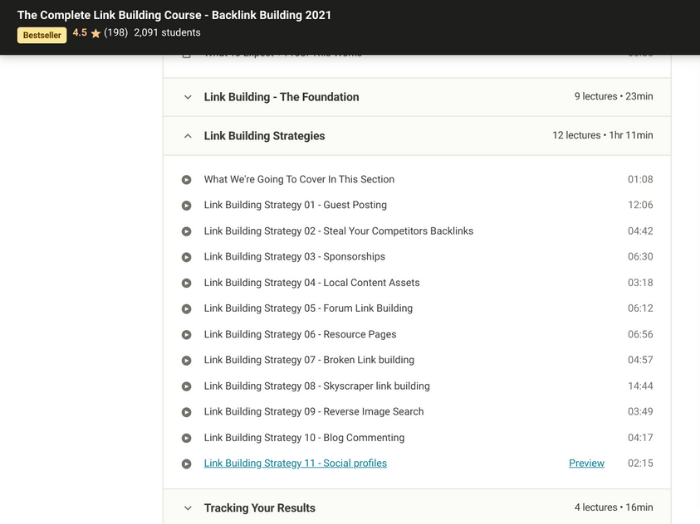
Note: Most courses at Udemy will typically cost you between $15–$199, although there are free courses available. If you have the budget for it, you can buy the course. Here, however, we’re just looking for ideas to organize your blog post from module titles, so there’s no need to sign up for the course itself.
From the highlighted module above, I can create five unique and high-converting headlines for my next blog post.
- 11 Traffic-Generating Links and Where To Get Them
- How to Use Broken Link Building to Create Links Google Will Love
- Traffic-Generating Links: Where to Get Them and Improve Search Traffic
- How to Get Traffic Generating Links with Help from Your Competitors
- The Best Way to Develop a Traffic-Generating Link Building Strategy
Spending just 10 to 20 minutes each week studying Udemy course modules will give you lots of ideas to write about and expand your analytical skills and give you a more thorough understanding of your industry and your target audience.
Overall, it’ll enhance your content marketing strategy and inform your content creation.
Just remember, the goal is inspiration; don't copy other people's work.
9. Craft Content Based on Your Core Values
Core values are the building blocks of every human being—and every business (or other organization).
Personal core values guide an individual’s behavior and choices. The same is true for your business’s values, as well.
For example, if you believe your target audience will benefit from the information you share, then you’ll research extensively and craft the best content possible.
Take the time to articulate your values in writing, just as Google and Buffer have. Google believes in putting users first. Buffer believes in showing gratitude, which helps make their social media management tool so valuable for content marketers.

There is no single rule for defining your core values. Just make sure each value originates from your deeply-held beliefs. When you start to write content based on what you truly believe in, you bridge the gap between your message and your readers’ expectations. Solid content creation will flow from there.
Storytelling can also help bridge that gap. From personal experience, I can tell you that it’s much easier to tell stories based on what I know and believe, instead of what someone else says or believes. Such a marketing effort will feel, well, effortless to your readers.
10. Use Native Ads, But Don't Be Deceptive
Native advertising is a form of online marketing in which the “ad” content matches the platform where it’s published.
Although we’re very accustomed to seeing this form of advertising, many people believe native ads are deceptive because they don’t “look like ads.”
It doesn’t have to be that way. Native ads can still offer value as something more than just a promotional piece.
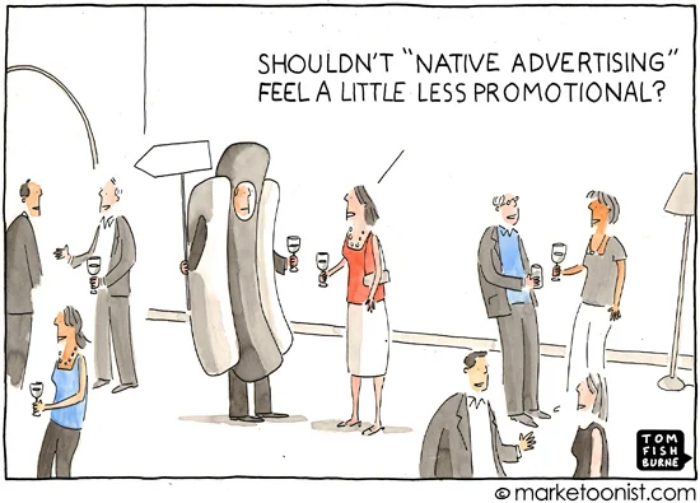
Whatever you may think about it, there’s no question that native advertising works. For example, Newscred regularly paid for sponsored content on LinkedIn, with an ROI of $17 for every $1 spent. That’s almost six times the ROI you can expect from Google Ads.
Although the stats point to native ads being an important content marketing tactic.
- Copyblogger Media shared 12 examples of native ads and why they work—ideally, as an integrated part of content marketing.
- A study by Forbes found that people pay 53 percent more attention to native ads than banner ads. Plus, they view native ads 53 percent more frequently than they view banner ads.
- According to Pardot, “Native advertising is actually a form of content marketing.” This means that it should offer some form of unique and useful information to the target audience.
According to eMarketer, native ad spend more than doubled between 2018 and 2020 and is expected to increase by 21 percent in the next year. If you want to join the trend as part of your content marketing tactics, make sure your ad is consistent with your other content.
Above all, native ads should meet the needs of your readers and engage the audience, just like your other content does.
Bottom line: Native ads work and will continue to work. The best practice is to approach it with your content marketing mindset and ensure that you use only high-quality content.
For example, if you decide to do sponsored posts or paid tweets, make sure that your landing page is well-designed and your content is crafted to welcome visitors and convert them into email subscribers or buyers.
11. Be Ready to Evolve
As Inc.com says,
Content marketing is always changing because the way we interact online is always changing.
You should be willing to change and adapt to the latest developments in your industry. That might mean enrolling in a content marketing course to further your education, or, it might simply mean reading extensively to stay on top of trends.
Business models evolve, and the only way to stay competitive is to always work with the most current information. Never be caught unaware.
As the business and content marketing world constantly evolves, you’ve got to keep your business viable. For example, you should keep abreast of Google’s algorithm updates if you want to keep generating sufficient search traffic.
I’m always ready to change what I’m doing if I find it’s no longer yielding significant results. I don’t throw in the towel and quit. Rather, I stay flexible and continually adjust.
You can do the same. Be prepared to satisfy your customers no matter what the economic situation or new government policy might be. It’s your responsibility to evolve for the sake of your target audience.
12. Conduct a Competitor Analysis and Work With the Data
Competitor analysis isn’t optional these days. You can effectively spy on your competitors to know exactly what they’re doing and find ways to outsmart them.
Industry experts agree that competitor analysis is an integral part of search marketing success. When its results are integrated into your strategy, competitor analysis can improve many aspects of your marketing, including your conversion rate.
The easiest way to know what your competitors are doing, in terms of where they’re getting backlinks and how many quality links they have, is to use the right automated tools.
First and foremost, you’ll want to find out who your strongest competitors are. You can use Google to search for your main keyword (e.g., beginners guide to blogging), then check which sites are competing with you.
Another way to perform competitor analysis is with Ubersuggest. Select competitive analysis from the left sidebar and then enter your domain.

You will then see a list of websites that compete for similar keywords. You can dig deeper into each competitor to find out which specific keywords you are competing for by clicking “view all.”

This provides an immediate picture of who you are competing with and what keywords you should target.
13. Get on the Local Platform
Not every visitor to your website is as valuable as the next. For example, if you’re a local brick-and-mortar business in Florida, getting thousands of web visitors from California doesn't do much good.
A recent study found 46 percent of Google searches are looking for local information, and this is hugely important for your business. Why? Because 78 percent of location-based mobile searches result in an offline purchase, so local SEO isn’t just a great tool to get your business found—it also drives sales.
Your content is a great opportunity to drive your local SEO. Create valuable information for people in your target area and make sure you’re focusing on local keywords (use Ubersuggest to discover local keyword opportunities).

Competing for big national keywords in competitive industries may not be possible, but it could be a realistic goal in your local area. Use my guide to local SEO to make sure you’re ranking for those important local keywords.
14. Use Emotional Keywords in Headlines
The best way to create magnetic headlines is to target emotional keywords. Doing so will supercharge your content. People will not only read it; they’ll be inspired to share it on social media and beyond as well.
For example, if you were trying to lose weight, you’d probably go to Google and search for keywords like the following:
- lose 10 pounds quickly
- fastest way to burn extra fat
- drop 20 pounds in 2 weeks
Here are more variations to the three search terms above:

In our example, if you found an article or video targeting any of the keywords above, you’d respond positively. That's because those keywords mirror what you deeply desire.
The same is true for your target audience. When they’re searching for keywords, and you notice a hint of immediacy, you know that those keywords will convert into clicks, visits, and sales when you eventually rank in Google.
Let’s assume you help companies and digital businesses to grow revenue. Here are some of the keywords you can use to create powerful headlines to grow your search traffic and rankings:

From the screenshot above, you can see the “emotional keywords.” I call them “emotional” because searchers are already pre-sold on the idea of increasing revenue. They’re just waiting for a nudge to take action.
To make your headlines high-converting, include numbers—especially odd numbers because some studies show odd numbers outperform even numbers.
Let’s craft some headlines based on those emotional keywords:
- 7 Powerful Revenue Generating Ideas You Can Use Today
- 9 Revenue Generating Ideas to Help Your Business Soar
- 6 Steps to Increase Your Sales Right Now
- How to Increase Sales in Your Small Business
Better yet, you could turn the emotional keywords into data-driven headlines to share your experiments and results:
- How To Increase Sales: An Experiment On How I Generated $25,000
- Case Study: How To Increase Sales as an Ecommerce Beginner
- 13 Revenue Generating Ideas That Yielded $10,837 Sales and 2,636 Email Subscribers
15. Create High-Quality Content
Worried you aren't a great writer? You’re not alone. According to research statistics from Teach Taught, “fewer than 50 percent of college seniors feel their writing improved during college.”
You can change that, starting today. It begins with fueling your passion for writing. After all, if you’re passionate about what you do, there is nothing in this world that can stop you. Success requires consistent effort, and it’s a whole lot easier to be consistent when you’re passionate about the thing you’re doing.
This simple formula shows you how to find your passion:

With time, you’ll find something you never believed you could do at all may become pretty easy.
Blogging and business require creativity, but it doesn’t necessarily have to come from your writing (it’s just not for everybody). It can also come from the way you manage other people. Modern technology has made it incredibly easy to work with freelancers around the world, and this can make a huge difference in your content marketing.
There are plenty of talented people that can help you expand your content output while still ensuring quality. It’s about being creative with your processes and putting the right systems in place to get the most out of your freelance team.
I never started as an expert. There was a time when I couldn’t put together a 500-word blog post. I had to continually learn and fuel my passion for writing. Eventually, I got better, learned more, and became the expert I wanted to be. You can follow this path and write your content, but you may have just as much success working with freelance writers.
Listen up: Successful content marketers don’t know it all. They’ve struggled to get things done, too. Because they’ve developed thick skins, they can meet the challenge and come out stronger and more influential.
16. Give Your Audience a Behind-the-Scenes Experience
If you want to attract a loyal audience and boost your site traffic, pre-sell your content and product. For example, if you are going to release a new post next week, tell your readers about the process of writing it before you publish it.
Behind-the-scenes experiences are welcome moments for your fans.

I do this a lot when I write content. I’ve even started doing it when I reply to comments as well, by telling my readers that I’ll be publishing a new post that will more thoroughly address their questions.
Another example of a “behind-the-scenes” experience is when Michael Hyatt asked his blog readers to help him choose the best cover for Living Forward, a book he co-authored with Daniel Harkavy.

Of course, this is also a type of pre-selling, because the customers and loyal readers now know the book's title, and will look forward to its launch. Now, the majority of them are ready to buy.
Before they buy, they’ll tweet the page, cite it in their blog posts, recommend it to others on their other social media platforms, and follow the updates. This will increase referral traffic to Michael’s blog and his search performance will likely improve as a result of social signals.
17. Curate Content Like a Pro
The internet is full of brilliant content.
You don’t always need to create fresh content from scratch because there are lots of other people out there who are also doing a great job at it. This is where content curation comes in.
It allows you to find the best content and bring it together in one place. Moz does this extremely well with its weekly round-up of SEO content.

Your goal is to bring people the best possible information, but it doesn’t mean you have to write it. As long as you’re crediting the content owners, you can use content curation to engage your audience and help solve their pain points.
This content marketing tactic is a great way to add to your content production, but consider what businesses you are linking to. Make sure you’re only sending your audience the highest-quality information, and be careful about sending people to your competitors.
A few tips to help you drive more traffic and leads from content curation:
- Research extensively for authority blog content. Don’t curate content from low-quality sites.
- Stay relevant. Every content page you curate into your list must be relevant to the topic.
- Design for user experience first, then optimize for the right keywords (but don’t stuff).
- Reach out to bloggers whose content you’ve curated and notify them. Most of them will share it if they believe their target audience will benefit from it.
If you want to give content curation a try, here's a guide that will walk you through the process.
18. Build Engagement on Your Own Space
Social media is one of the best ways to reach your audience today. If you’re not marketing yourself on social media, you could be missing out on a huge portion of your audience.
It’s not just about building out your profiles and engaging people through the platform, though; it’s also about what action you want followers to take. One of your goals with social media should always be to bring people to your own space.
You have more control over your blog and email list than any social media profile or platform. No matter how successful you are on social; you don't own that connection. Make sure you’re not abandoning your blog audience for social followers.
Grow your social media presence, but make sure you’re using it to bring people to a medium you control. From here, you can control the customer journey, build your email list and nurture your subscribers.
19. Create an Editorial Calendar
An editorial calendar helps make your content marketing strategy low-stress and rewarding. Unfortunately, most people never take the time to craft a plan for creating content, marketing it, and tracking its effectiveness.
The importance of an editorial calendar can’t be overemphasized. You need to develop yours as quickly as possible and use software to guide your process:
- Trello
- Asana
- Monday.com
- ProofHub

The three steps you need to take to make your editorial calendar effective are:
- know your audience and the content type they’re interested in
- research your topic thoroughly
- create content and measure its effectiveness
Remember to keep a steady flow of content going out. That’s the way to generate more leads and indexed pages and improve organic traffic.
20. Get Maximum Mileage Out of Your Content
Blogging can help you reach more of your target audience, particularly if your blogs are frequently shared across social media channels. How do you get more referral traffic from your content, though?
You’ve got to think outside the box. Inbound marketing works, but you've got to diversify your efforts if you want to get outstanding results. The majority of your target audience hasn’t visited your blog yet. They are, however, on Slideshare, YouTube, and other content platforms.
You’ve got to be everywhere they are. Your content should make a mark online. If you’ve spent your precious time creating great content, don’t let it sit there in oblivion.
It's time to embrace content repurposing.
This content marketing tactic helps you make the most of your content by using it in different formats.
For example, you could take an article, convert it into a PDF report and offer it as an e-book. You could also create PowerPoint presentations and upload them to Slideshare or create an infographic out of a case study.
Be very careful to repurpose only your high-quality content that produced measurable results the first time around. Not every piece of content will work for this purpose.
21. Invest in Learning About Your Audience
The web is a virtual university. You can learn just about anything online if you know where to look. Content marketing will continually produce high ROI when you give it time and consistently work to upgrade your knowledge and skills.
According to Bianca Male,
Listening is often the best form of learning.
The bad news is that your competition will continue to get more intense. The good news is that we’ve never had so many effective and affordable tools and knowledge resources from which to learn.
Using the right marketing tools, developing your skill sets, and networking smartly will get you to the top. If you want to succeed and reap huge dividends, channel your learning efforts towards better understanding your target audience.
22. Be a Little Weird
Everyone loves a company that is willing to go against the grain. There is something about a healthy dose of irreverence and tasteful humor that increases the likability of brands.
It also makes you stand out from your competitors.
Tons of businesses send out the same message, which means consumers notice funny or weird marketing campaigns. They’re a breath of fresh air in a world of cloned marketing tactics.
Dollar Shave Club creates weird, creative, and outright bizarre content. I’ll bet you can’t help but laugh when watching this video.
If you think this video is funny, but that it couldn’t possibly increase revenue or help business, I understand, but that’s simply not the case.
Dollar Shave Club spent $4,500 to create the video, but they more than made that money back. The video has 24 million views on YouTube. They gained 23,000 followers on Twitter and 76,000 Facebook fans from the campaign, and most importantly, they attracted 12,000 new customers in two days.
It turns out that being funny, weird, and irreverent can pay off.
Dollar Shave Club continues that unique brand identity with its Bathroom Minutes articles, and their customers love it.

Similarly, Denny’s uses its blog to put out content in the same style as Dollar Shave Club. Its content is unconventional as this image of a married couple pulling a morning breakfast with their car shows.

Snickers tapped into the weird trend as well, creating its “You’re not you when you’re hungry” marketing campaign.
It also did an AdWords campaign targeting misspelled searches.

What’s the point of all this marketing weirdness?
People like it when your brand does something different. Don’t be afraid to mix it up and see what happens.
Nothing risked, nothing gained; so get out there and do something weird.
23. Respond to Twitter Mentions
I can’t overstate the power of responding to people who are talking about your brand.
Why?
Because responding to real people’s questions, comments, and concerns humanizes your brand. It tells people that your company isn’t just some inhuman entity. Rather, you’re a company that cares about its customers.
Twitter makes this particularly easy, notifying you whenever someone mentions your company’s name.
If you quickly and consistently respond to your customers’ comments and concerns, this shows a level of dedication that will impress your followers.
That’s good news for your business. Responding to people regularly shows you care.
The more people tell their friends about your product, the more products you’re likely to sell—and the more successful your business will be.
When a friend recommends a product, they mean it.
By thinking creatively about your product and doing something that no one has ever done before, your product is more shareworthy. Coca-Cola did a good job with this with their Share a Coke campaign.
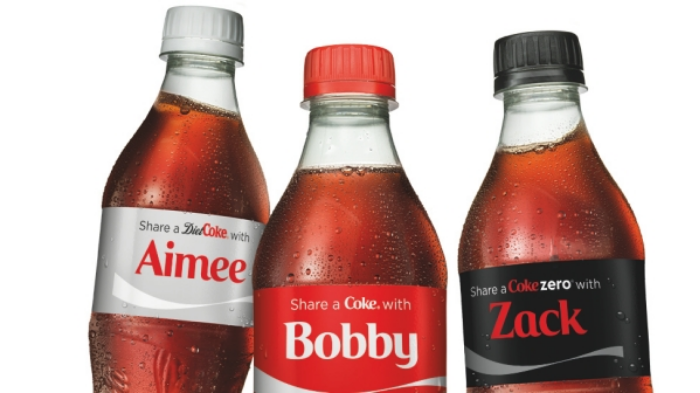
They put individual names on each bottle of Coke, personalizing the experience for their customer base. They then encouraged people to share a Coke with a friend and post a photo using the hashtag #ShareaCoke.
In the end, the campaign generated 998 million impressions on Twitter and 235,000 tweets with the hashtag. They sold more than 150 million bottles of Coke, too.
When the experience is unique, consumers want to participate, and they want to share it with their friends.
Burberry ran a similarly share-worthy campaign called Burberry Kisses.
By collaborating with Google, Burberry allowed people to send each other “kisses” with digital messages. Since it was new and different, consumers couldn’t help but try it out. Every time someone sent a kiss to a friend, that person saw the Burberry logo, which increased Burberry’s brand awareness and engagement.
When people share your product, more people buy your product. It’s that simple.
25. Pay Attention to Upcoming Tech
Technology moves fast. The newest piece of revolutionary tech seems to hit the market every week. If you pay attention to these interesting innovations, you can hijack their attention.
The New York Times did this when they created NYTVR (New York Times Virtual Reality). The marketing campaign required users to have Google Cardboard and the free New York Times app.
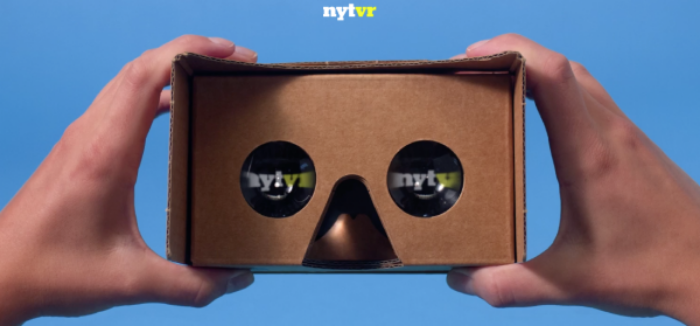
Users could then experience the world in a different and fun way with a 360-degree view of a video. By leveraging upcoming technology, the New York Times positioned itself as relevant and edgy.
Campaigns with modern tech show consumers that you’re listening to trends and keeping up with the times.
26. Tell Compelling Stories About Your Users
People who’ve used your product are the best salespeople. That’s why testimonials on a landing page and social proof on an e-commerce site are so powerful.
Most people want to feel confident about buying your product. They don’t want to be the first one to try it. They need to know that other people like it before they take the leap.
By listening to the stories your customers tell about your product and creating content around those stories, you’ll inspire confidence in your brand. Microsoft does just that with its “Story Labs.”

This blog tells the stories of people who buy their products, make their products, and inspire their products. By sharing these engaging stories, Microsoft is positioning itself as a trusted business and convinces consumers its products are worth buying.
Eventually, first-time buyers will step up to the plate and try out Microsoft’s goods because of this.
27. Encourage User-Generated Content
For some businesses, user-generated content is their content marketing bread and butter.
When companies encourage customers to create content for their brands, it’s a double win: the company saves time and money, and they distribute compelling content.
GoPro does a good job of encouraging and posting user-generated content. Consider this video made by an avid “Go-Proer.” Start watching at 1:28 and cringe a few seconds after as you see what happens.
This video has over 13 million views, and it generated a ton of brand awareness for GoPro. All of that was at no cost to the business. Since the user created the content, the business simply stood by and watched while their product was marketed for them.
26. Use Your Product in a New Way
Can you dream up a new way of playing with your product?
It isn't always easy, but it can be an effective marketing strategy. Take Blendtec, a company that sells blenders, as an example.
They were unsure how to market their blender and stand apart from the hundreds of other options. Then, they came up with a brilliant idea. They started a show called, “Will It Blend?” where they blended everything from marbles to iPhones.
Don’t believe me? See for yourself here:
And here:
By thinking about the blender in a creative and interesting way, Blendtec became one of the leading sellers of blenders and appealed to consumers all around the globe. Millions of people have watched their videos. That last video has over 4.5 million views alone!
If they can do it with a blender, the chances are you can do it with whatever product you sell.
28. Educate Your Customers
Creating educational content around your product might not seem like the best idea.
Do people really care about how your product works? Do they want to know the ins and outs of how you created it?
It turns out that a lot of times, they do.
It depends on your target market, but people are always interested in learning more about how a device functions. Remember: people love to know stuff that their friends don't know. It makes them look smart, and they'll usually share their newfound knowledge.
Magnolia used customer education to its advantage.
Unsure of how to market their products on a low advertising budget, they decided to create a blog. The blog discusses what electronic products to look for when making a purchase, what to watch out for, how electronics work, and how amazing they are.
What was the result?
Shortly after creating this educational content, Best Buy bought the company for $87 million.
As it turns out, few companies were taking the time to educate their customers about electronics. Magnolia took a leap and went in a different direction and made a massive amount of money from it.
Your customers want you to educate them, especially if there aren’t a lot of people teaching them about a certain product or industry.
29. Be More Transparent About Your Products
Transparency is scary for individuals and businesses alike. What if people respond poorly to who you are or what your business is?
I won’t lie to you: when you tell people about the real you, there’s a chance they won’t like it. I guarantee that some people won’t like it. You can’t please everyone, but I also guarantee that some people will.
It won’t just make you more likable. It will allow you to address your customers' concerns and create a bond they will remember.
McDonald’s is a company that’s undergone a lot of scrutiny for its food’s quality. They decided to increase their brand’s transparency with their bold, “Our Food. Your Questions.” campaign where they answer questions customers have about their food. This campaign gave them the chance to debunk particularly heinous rumors about their food.
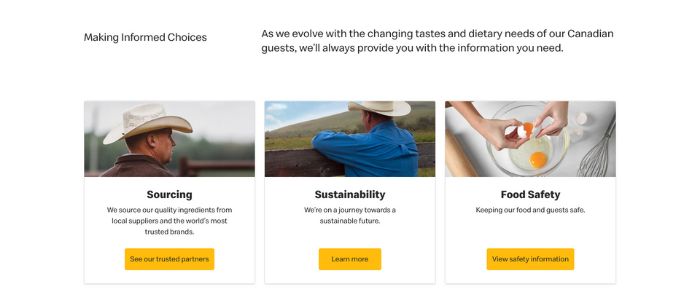
One rumor, for example, was about “pink goop” in McNuggets. In response, McDonald’s eradicated the myth by creating this video that shows how they make their McNuggets.
When you take the time to listen to and answer customers’ questions honestly, people will trust your company. Rumors spread about every brand; creating content around frequently asked questions is a great way to debunk revenue-killing myths.
30. Hijack Trending Topics
There is always something trending online, and you can use trending topics to your marketing advantage.
How?
By creating content that plays off of them.
Hootsuite made the video “Game of Social Thrones.” That’s right, a social media tool used Game of Thrones.
How did they do this? It got creative and found a way to connect the trending topic to its brand.
While “Game of Thrones” is popular, it isn’t always the talk of the town. Other topics often are at the forefront of consumers’ minds so how do you figure out what topics to talk about?
It’s easy.
Go to Google Trends.
Glance through the topics on the homepage. These are topics that are currently getting a lot of search traffic on Google.
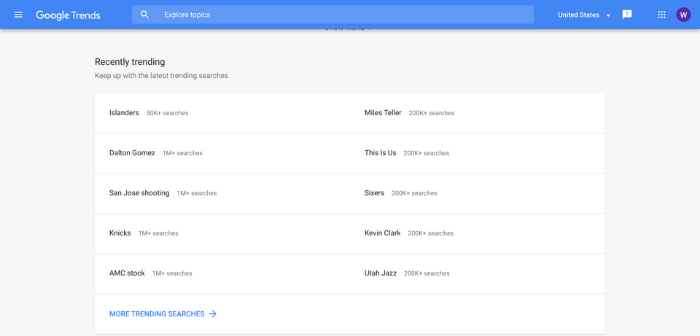
Use Google Trends to find trending topics to hijack with your content marketing strategy. Doing so can give your content the same appeal as the trending topic.
It’s always important to remember your brand image, though. There are certain topics you don’t want to be associated with your brand, so make sure you’re hijacking the right trends.
Content Marketing Tactics FAQs
Yes. Your content walks the customer through their pain points and gives them actionable advice on how to fix their problems. In short, it’s the moment where your relationship with the customer begins, making it crucial to a successful online marketing strategy.
Every business is unique. What works for one website might not necessarily work for another, so what’s important is that you find the blend that works for you. Focus on creating high-quality content, then test these strategies to see what works for your audience.
Running A/B split tests is crucial if you want to know which headlines, calls-to-action, and types of content work best for your readers. Once you know what strategies work best for you, your overall content marketing strategy becomes far more effective.
Yes, you need an editorial calendar to make your content marketing strategy low-stress and rewarding. Taking the time to create a calendar keeps your content production consistent and more effective.
Content Marketing Tactics Conclusion
If you’re not seeing the results you want from your content marketing, then there are lots of different tactics you can use. Not every tactic will suit your business, so test to see which ones work best to engage your audience.
I’ve grown my brand off the back of content marketing. Using these content marketing tactics will help you do the same thing.
Focus on creating exceptional content and use these tactics to take your marketing to the next level. If you do this successfully, then you’re likely to reach more people, get more engagement, and achieve more of your marketing goals.
What’s your favorite content marketing tactic?
————————————————————————————————————————————–
By: Neil Patel
Title: 30 Content Marketing Tactics You Have to Try
Sourced From: neilpatel.com/blog/unconventional-content-marketing-tactics/
Published Date: Tue, 22 Jun 2021 13:00:00 +0000
